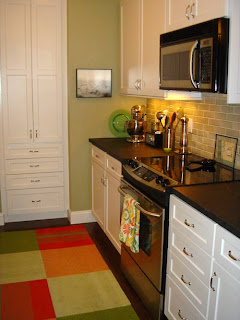So you have to understand - back when I was an itty-bitty college gal, I lived and died by Marjorie Garber's brilliant analysis of gender. So to find that she's written a scholarly book about real estate is very exciting! I couldn't find it in the library today, but I did find this summary:
Sex and real estate: why we love housesGarber, Marjorie B.
Summary: Sex and Real Estate is a witty, informative, and thought-provoking study of our complex relation to the ideas and actualities of house and home. With vast erudition lightly carried, Marjorie Garber - professor of English and director of the Humanities Center at Harvard University - ranges through literature, art, film, journalism, criticism, and the hard evidence of everyday experience, and gives us an acute analysis of the ways in which we think about the places we hang our hats. She discusses the House as Beloved ("Your house is the other person in your life," declares an architectural designer.), as Mother ("The house, we would like to think, loves us."), as Body ("both an ancient figure and a persistent desire"). She writes about the Dream House, the Trophy House ("We could call the purchasers of celebrity homes 'house-groupies.'"), the House as History, and the Summer House ("When you're seventeen, you dream of a summer romance. When you're forty-seven, you dream of a summer home."). Each chapter is a superb, individually constructed essay. Taken together, they add up to an enlightening and challenging exploration of one of the most familiar - but also most emotionally charged - elements of our lives.
Reviews: Anyone who has looked, even casually, at what are called "shelter" magazines, or who has engaged in the exhausting process of buying or selling property, will have been struck by the peculiarly erotic quality of the language used to describe the houses we live in or seek to own. Perhaps prompted by her own foray into real estate, Garber, author of Symptoms of Culture and Dog Love, among many other books, applies her richly stocked scholarly imagination to a consideration of the cultural role of the house. In a series of witty essays on the "House as Mother," as "Beloved," as "Body," as "Trophy" and the like, Garber segues smoothly in the course of a page or two from Freud and Jung to Chaucer, Shakespeare and popular film, effectively elaborating her contention that the house is not just something on which we lavish our erotic or emotional attention in lieu of a more appropriate object, but is also "a primary object of affection and desire." As a professor of English at Harvard and director of its Humanity Center, Garber is an established academic. While dazzling, her erudition is not intimidating; this book is bound to prompt lively after dinner discussion and perhaps a little abashed self-recognition in the nation's suburban great rooms and downtown lofts. (Credit: Cahners Business Information, Inc. Appeared in: Reed Elsevier Inc.)
Despite the title, this book is much more entertaining and witty than frivolous. Garber (English, Harvard Univ.) has published books on the psychological aspects of cross dressing, "symptoms" of culture, and dog love. Her new book has an easy writing style, appealing to the academic researcher, the student, and the browser. She advises in the introduction that her "chapters explore the cultural role of the house as mother, lover, body or self, fantasy, trophy, history and escape." Whether the book is cataloged as a study of architecture, house and home, sexual fantasy, or the home in popular culture, there is something of interest to a wide audience. (Credit: Mary Hamel-Schwulst, Towson Univ., MD Appeared in: Reed Elsevier Inc.)
Harvard University professor Garber has placed her latest book precisely on the desirable property line between academic and popular literature. Her theme draws parallels between romance and real estate. After all, Garber writes, we dream of certain houses. We "cruise" a house before making a proposal. We may yearn to possess a house anxiously, for weeks, before acquiring it and living with it; eventually, we leave it, hoping for something better. Garber's chapters meditate on different aspects of the home: the home as beloved, as a status symbol, as a reflection of our relationship to our history (what's that butter churn doing in your living room, anyway?). Drawing on diverse cultural references, Garber reviews the history of houses in society, their architectural styles, the various uses of rooms and furnishings, and the always-booming "nest" magazine industry (today's "yuppie pornography"). For professional realtors hoping to glimpse into the windows of their clients' psyches and for any reader who shares Garber's romantic attachment to houses, this book is sure to be a very hot property, indeed. (Credit: James Klise Appeared in: Syndetics Solutions, Inc.)
Despite its title, this is a serious and literate book in which the author addresses why and how we love houses. The romance of real estate and architectural seduction impinge in wondrous ways on our lives. Even a reader who has lived all of her or his life in the same house will find emotional reference and behavioral relevance, if not opportunity for domestic self-reflection, in this cultural study. Indeed, the author asserts that our relationships with our houses and their spaces are as fulfilling, and perhaps more self-conscious, than are our relationships with lovers. Full of literary references as well as factual anecdotes, the book covers cabins to castles; dream houses, trophy houses, and summer houses; and topics ranging from the house as body, as beloved, and as mother, to the house as history. The book is enjoyable and accessible to all educated readers and should provoke interesting academic discussion. Credit: Syndetics Solutions, Inc.)
Table of Contents
Introduction: Sex and Real Estate 3
1 The House as Beloved 25
2 The House as Mother 48
3 The House as Body 71
4 The Dream House 100
5 The Trophy House 120
6 The House as History 150
7 The Summer House 181
Epilogue: Why We Love Houses 205
Notes 209
Index 231
How cool does that look? Now I just have to find it!





